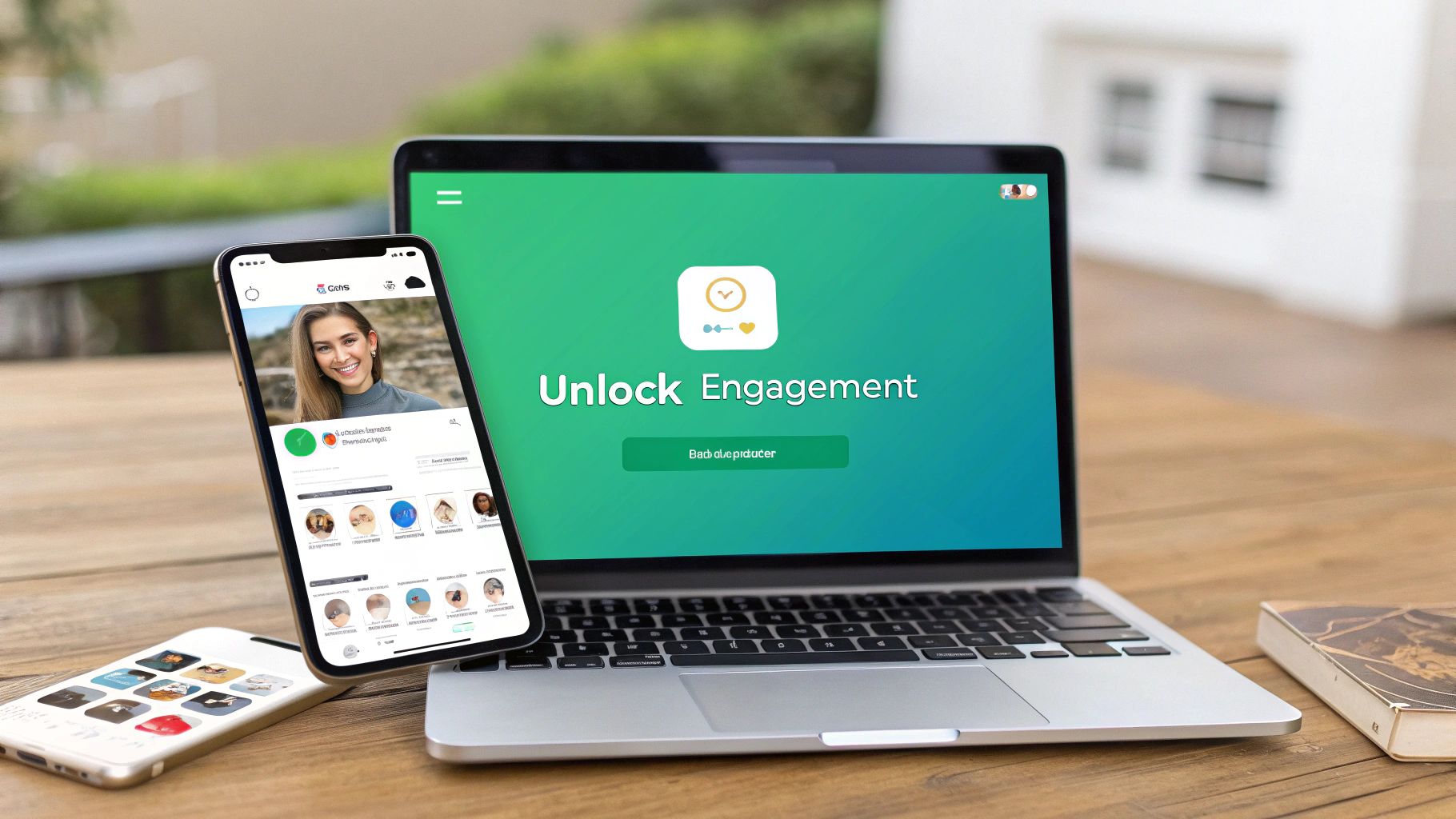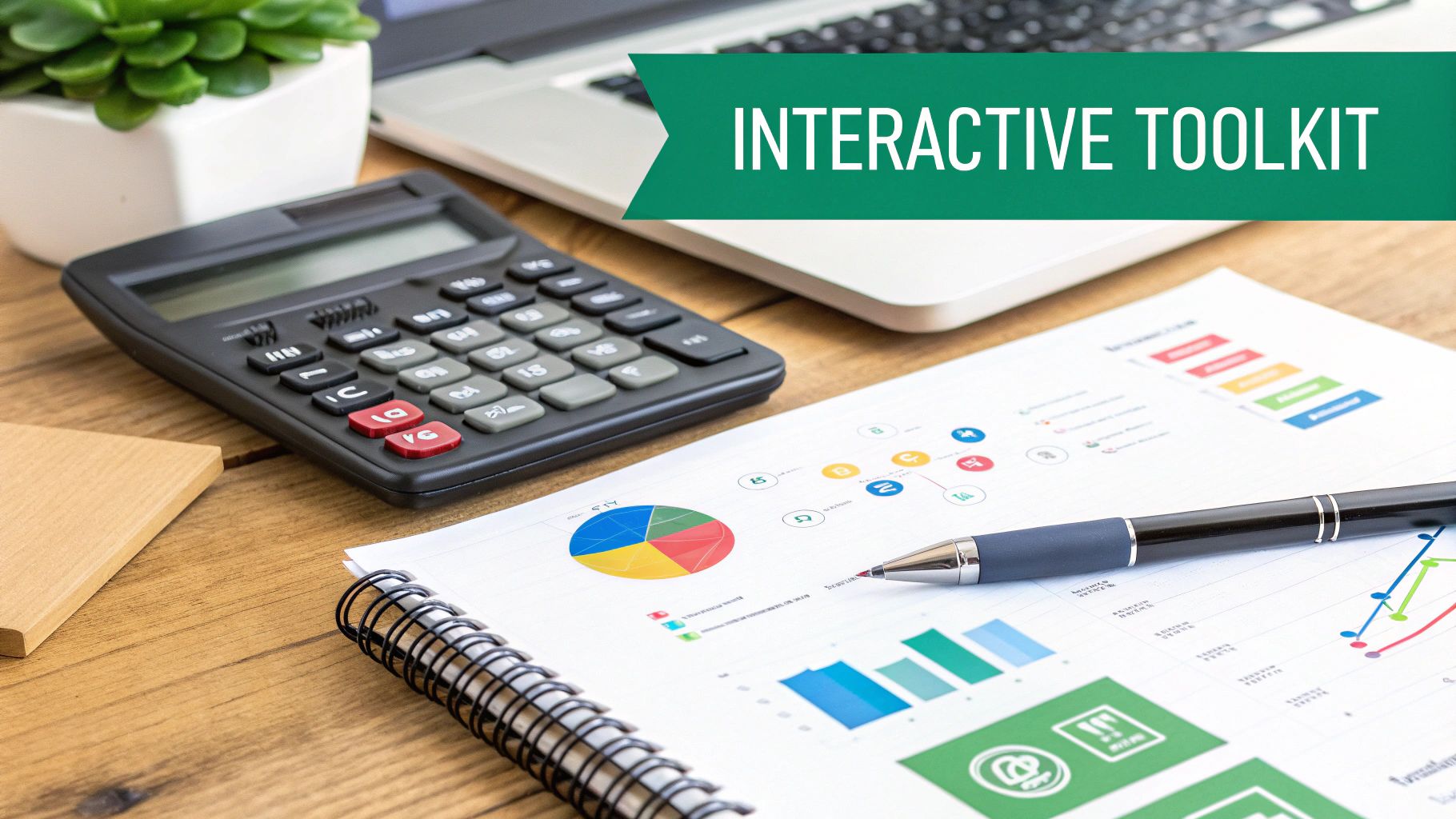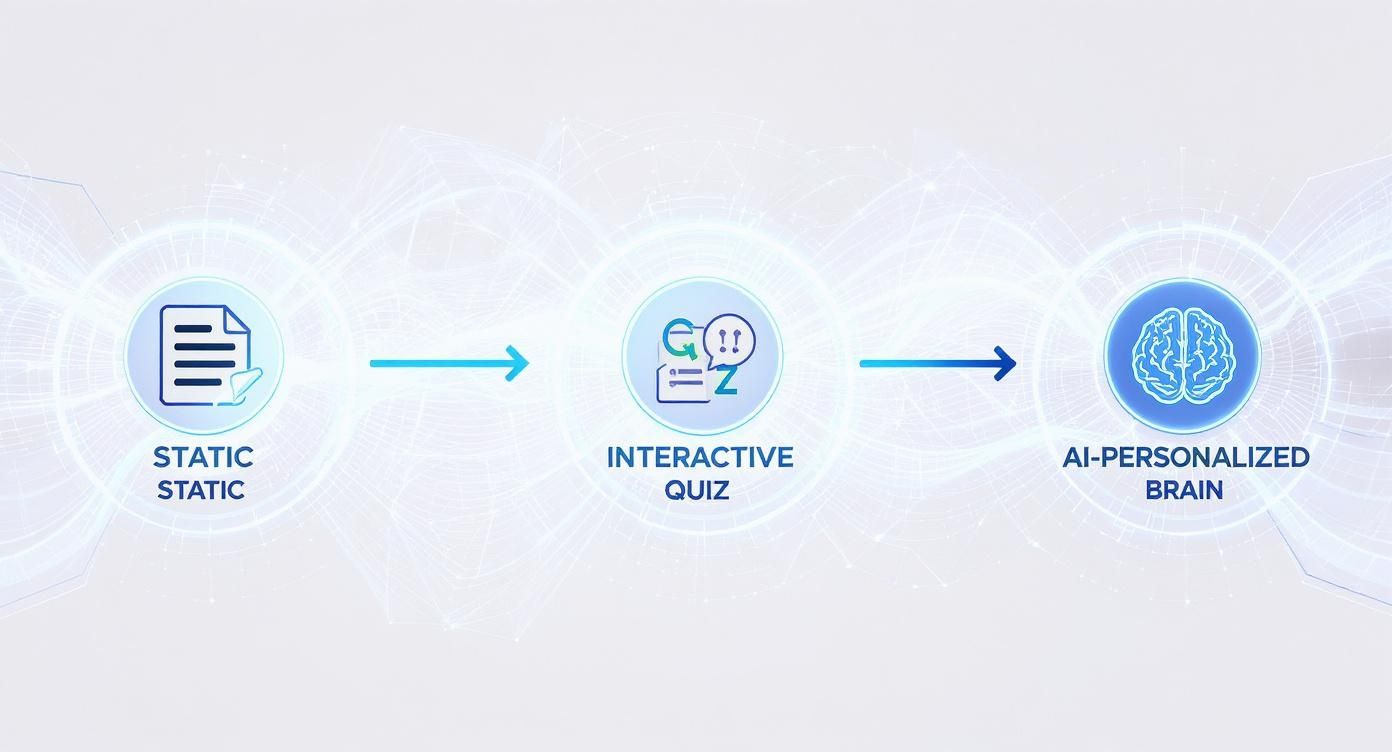Unlocking Engagement With Interactivity On Websites
Discover how interactivity on websites can transform user engagement and boost conversions. Learn to build interactive experiences that captivate your audience.

Think of your website for a moment. Is it a static, digital brochure that people just flick through? Or is it a dynamic, two-way conversation that pulls them in? That's the core of website interactivity: transforming passive visitors into active participants by inviting them to click, scroll, and engage, not just read. It's the difference between handing someone a leaflet and giving them a hands-on workshop.
Why Your Website Is A Monologue In A World Craving Dialogue

You've probably poured countless hours into your website. The copy has been tweaked, the design polished, and everything looks pixel-perfect. And yet, when you check your analytics, you see the same old story: people land, glance around for a few seconds, and leave. It’s like shouting into an empty room.
This is a common frustration, and it happens because most websites are built as one-way streets. They broadcast a message—here’s who we are, here’s what we sell—but they don't listen or react. They are, in essence, digital monologues, throwing the same block of content at every single visitor, regardless of what they actually need or want. In a world where people expect connection and personalised experiences, this static approach simply falls flat.
From Passive Reading to Active Doing
The way we use the internet has completely changed. We're no longer content to just sit back and read; we want to be part of the action. We expect to interact, get answers on the spot, and feel like our time on a site actually matters. This is exactly the problem that interactivity on websites is designed to solve.
Just think about the last time you used a genuinely helpful online tool. Was it a mortgage calculator that instantly showed you what you could afford? Or maybe a fun quiz that revealed a surprising personality trait? These experiences are memorable because they offer value in exchange for your participation. They flip the script, turning a monologue into a meaningful dialogue.
True interactivity isn't about adding flashy animations for the sake of it. It’s a fundamental shift from broadcasting a message to building a conversation. It respects the user's time by giving them a direct path to the specific value they're looking for.
AI: The Next Leap Forward for Interactivity
Here’s a slightly controversial take: most companies are still stuck in the past, debating whether to offer a static PDF or a basic quiz as a lead magnet. All the while, a massive shift is happening right under their noses, and very few are grasping its full potential. Artificial intelligence is about to make interactive funnels and audit tools 10 times more powerful.
Imagine an assessment that doesn't just spit out a generic score. Instead, it delivers a deeply personalised action plan that feels like you've just had a one-on-one consultation with an expert. That's where we're headed. AI can take a simple quiz and make it dynamically adapt to a user's answers, creating a hyper-relevant experience that builds incredible trust.
As builders, this is what gets us excited—crafting these engaging, responsive experiences that solve real-world problems for users. Forget about churning out generic, AI-written blog posts. The real opportunity lies in using AI to build simple but powerful tools that generate leads and traffic by providing genuine, interactive value.
What Does "Interactive" Really Mean on a Website?
Let's clear the air on something important. When we talk about "interactivity," we're not just talking about a button that changes colour when your mouse hovers over it. Those little visual flourishes—often called micro-interactions—are nice, but they're only scratching the surface.
At its heart, genuine website interactivity is all about a value exchange. It’s a two-way street. You ask your visitor to do something—click, type, drag, or answer a question—and in return, you give them something immediately useful and personal. Think of it as the difference between a static textbook and a personal tutor.
A standard webpage, like a blog post or a downloadable PDF, is the textbook. It presents the same information to everyone, leaving them to hunt for what’s relevant. An interactive experience, however, is the tutor. It asks questions first to understand the visitor's unique situation and then delivers a solution built just for them.
From Simple Clicks to Real Solutions
Website interactivity isn't a single thing; it's a spectrum. It helps to break it down into a few levels based on the value they provide.
- Feedback Loops: These are the most basic interactions. A button might animate when you click it, or a form field turns green to confirm you've entered something correctly. They’re simple confirmations that make the site feel responsive.
- Guided Discovery: This is where it starts to get compelling. Imagine a product configurator that lets you build your ideal car, or a quick quiz that helps you find your personal style. These tools guide people through complex decisions in a fun, engaging way.
- Personalised Diagnosis: This is the top tier. Here you’ll find calculators, assessments, and audit tools that deliver deep, personalised insights. They take what the user tells them and create a genuine "aha!" moment.
A classic example is a return-on-investment (ROI) calculator. It doesn't just list product features. Instead, it asks for your specific business numbers—like current website traffic or conversion rates—and instantly calculates the potential financial return. This shifts the conversation from a vague sales pitch to a rock-solid business case.
The real aim isn't just to make your website "do stuff." It's to start a conversation where your visitor feels heard, understood, and genuinely helped. Every single interaction should bring them one step closer to solving their problem.
Why This is Your New Secret Weapon
We're all drowning in a sea of generic, AI-generated content and tired lead magnets. In this environment, offering a truly helpful, interactive experience is a massive advantage. While your competitors are pushing out the same old PDFs, you can build a simple tool that delivers instant, customised value.
Even a simple quiz or a basic diagnostic tool can bring in highly qualified leads and traffic. Why? Because you're starting the relationship by giving, not just asking. You build trust and prove your expertise right away, making people want to hear what you have to say next.
Your Toolkit For Interactive Content That Converts

Alright, moving from theory to practice, let's look at the actual tools that make your website come alive. These elements can be simple or sophisticated, but they all hinge on one critical goal: giving your visitors real value through participation.
Most agencies won’t tell you this: so many businesses get obsessed with creating flashy, complex interactive experiences, thinking they need a Hollywood-sized budget to make an impact. That’s a huge mistake.
A well-built calculator or a sharp diagnostic quiz will outperform a flashy but unfocused project almost every time. It’s not about the budget; it's about solving a specific, painful problem for your audience. These tools are your secret weapon against the tide of generic, AI-written articles and tired PDF lead magnets everyone else is pushing.
Quizzes That Diagnose And Qualify
Quizzes are an absolute powerhouse for engagement. Why? Because they tap into a fundamental human curiosity: we all want to learn more about ourselves and our situation.
A good quiz isn't a silly distraction; it's a diagnostic tool. It guides people to self-identify their biggest challenges.
Instead of a generic "Download our e-book," imagine offering a quiz like, "What's Your Biggest Marketing Bottleneck?" The user answers a few targeted questions and gets a personalised result diagnosing their specific problem. You're not just handing them content; you're giving them clarity. That's a far more powerful way to start a relationship.
Calculators That Provide Instant Clarity
Calculators are one of the most potent forms of interactivity on websites because they instantly answer the one question every single prospect has: "What's in it for me?" They slice right through the marketing waffle and deliver cold, hard numbers.
Consider these practical examples:
- ROI Calculators: Show a potential customer the exact financial return they can expect from your service. This turns a vague promise into a solid business case.
- Savings Calculators: Help users see precisely how much money they could save by making a switch to your solution.
- Pricing Configurators: Let people build their own package and see the cost in real-time, which builds trust through transparency and control.
These tools are incredibly effective because the value exchange is undeniable. The user gives you a few details and gets a valuable, personalised calculation in return. That builds massive trust and pre-qualifies them in the process. Once set up, many of these tools can generate high-quality leads for years with very little ongoing effort.
Interactive Tools Versus Static Content
| Attribute | Interactive Content (Quizzes, Calculators) | Static Content (PDFs, Blog Posts) |
|---|---|---|
| User Role | Active Participant | Passive Consumer |
| Value Delivery | Immediate & Personalised | Delayed & Generalised |
| Data Collection | Rich, Segmented User Data | Basic Contact Information (if any) |
| Lead Quality | High-Intent, Pre-Qualified | Low-Intent, Unqualified |
| Engagement | High; users invest time & thought | Low; often skimmed or ignored |
| Conversion Rate | Significantly Higher | Much Lower |
The table makes it clear: interactive content isn't just a gimmick. It’s a fundamentally better way to engage potential customers by turning a one-way broadcast into a two-way conversation.
The Emerging Power Of AI-Enhanced Audits
This is where things get really interesting, and it’s a space where most businesses are still behind the curve. You can take a simple interactive tool and use AI to make it 10 times more powerful.
A traditional audit tool might give a generic score. But an AI-powered audit can deliver a deep, personalised analysis that feels like a one-on-one consultation.
For example, our own free tool, Magnethive, does exactly this. It doesn't just grade your lead magnet; it generates a full report with AI-driven ideas for improvement and even shows the potential ROI of those changes. This provides immediate, tangible value and positions you as an expert worth trusting.
The magic of these tools—quizzes, calculators, and AI audits—is that they transform your website from a passive brochure into an active consultant. For more on how to present these tools for maximum impact, check out our guide on optimising your interactive tool's landing page.
Where AI Really Changes The Game For Website Interactivity
Let's talk about the future, because it’s already here, and almost everyone is missing the point. When most people hear "AI and websites," their minds jump straight to generic chatbots or content-spinning tools. Frankly, that’s like looking at a rocket and only seeing a metal tube.
The real revolution is how AI is set to supercharge website interactivity, making our current tools look like relics from a bygone era. We're on the cusp of an evolution that will move us from simply offering pre-programmed responses to delivering truly dynamic, consultative experiences.
This is the next frontier. It’s about weaving a layer of intelligence into every interactive touchpoint, making the experience hyper-relevant, deeply personal, and incredibly memorable. As someone who builds this stuff, this is what gets me genuinely excited—the power to create digital experiences that don't just respond but truly understand.
Moving Beyond Static Logic
Think about a standard online quiz. It follows a rigid, branching path. If a user chooses option A, they see question B. If they pick option C, they go to question D. It’s clever, sure, but it’s still just a pre-defined flowchart. The logic is static.
Now, imagine that same quiz powered by AI. It doesn’t just follow a script. It analyses the user's answers in real time, picking up on nuances, confidence levels, and the underlying intent behind their choices.
This AI-driven quiz could:
- Dynamically Rephrase Questions: If a user seems confused or hesitates, the AI could reframe the next question to be clearer or add more context.
- Generate Personalised Follow-ups: Instead of spitting out one of three generic outcomes, it could generate a unique summary and a set of recommendations based on the specific combination of answers.
- Adapt the Entire Funnel: Based on the user’s self-identified weaknesses, the AI could alter the very next page they see, the email they receive, and the solution it presents.
This isn’t just a better quiz; it’s a fundamental shift from a one-size-fits-many interactive tool to a one-to-one digital consultation. It’s the difference between a self-help book and a personal mentor.
100% Free Lead Magnet Audit
Our AI analyzes your website and delivers custom growth strategies in seconds.
The Rise of The AI-Powered Audit
This is where the power of AI in website interactivity becomes undeniable. A standard assessment tool is limited; it checks a few boxes and spits out a generic score. "Your website SEO is a 7/10." Okay, what do I do with that? It's interesting, but not truly actionable.
Now, let's inject AI. An AI-powered audit tool goes miles deeper. It doesn’t just give you a score; it provides a diagnosis and a prescription.
The current obsession with churning out endless streams of AI-generated blog posts is a massive distraction. The real, lasting value comes from building simple, AI-enhanced tools that solve a user’s problem on the spot. A single, well-built AI audit tool can generate more qualified leads and build more authority than a hundred generic articles ever could.
Why This Is Your New Competitive Edge
Very few have grasped the full potential here. They're still debating the merits of a static PDF lead magnet versus a basic Typeform quiz. Meanwhile, the opportunity to build interactive experiences that are 10 times more powerful is wide open.
This isn't about creating Skynet. It’s about using AI to add a layer of deep personalisation that was previously impossible to scale. It’s about creating that "wow" moment for a visitor where they feel completely seen and understood by your brand, building incredible trust from the very first interaction.
If you want to see this principle in action, try a tool like Magnethive. It's a 100% free lead magnet audit that uses AI to generate a comprehensive report with personalised ideas and ROI projections. It’s a perfect example of how AI can transform a simple check-up into a deeply valuable, consultative experience that provides immediate, tangible value. The future of interactivity isn't just about clicks and swipes; it's about genuine intelligence.
How To Build Your First Interactive Funnel
Alright, let's get our hands dirty and move from theory to practice. It’s one thing to read about interactivity on websites, but it’s another thing entirely to build something that actually gets results. The good news? You don’t need a massive budget or a team of developers to get started. All it takes is a sharp focus on your audience’s biggest headache.
Think beyond the usual PDFs and lifeless newsletters. We're aiming for a value-first exchange. The plan is to create a simple yet powerful quiz funnel that pinpoints a user's problem and delivers instant, personalised feedback. This single shift turns a cold, transactional lead magnet into a warm, helpful conversation.
Step 1: Identify The Core Pain Point
Every truly effective interactive tool is born from answering one simple question: What's the single most frustrating problem my ideal customer is grappling with right now? Don't just guess. Dig into your support tickets, really listen during sales calls, and lurk in the forums where your audience vents their frustrations.
You're looking for the recurring theme. Is it confusion over which software to pick? Uncertainty about their marketing ROI? A constant struggle to qualify leads? Whatever it is, that pain point is the bedrock of your entire funnel. For example, a financial advisor might realise their clients are constantly worried they aren't saving enough for retirement.
Step 2: Design A Diagnostic Quiz
Now, let's frame that pain point as a compelling question. For our financial advisor, the quiz title could be something like: "Are You Really on Track for Retirement?" That question alone is enough to stop their target audience in their tracks.
The questions you ask shouldn't be random trivia; they need to be strategic. Each one should guide the user through a process of self-diagnosis.
- Assess their current situation: "What is your current age?" or "What percentage of your income do you save?"
- Clarify their goals: "At what age do you hope to retire?" or "What kind of lifestyle do you envision?"
- Uncover their challenges: "What’s your biggest obstacle to saving more?"
Each question should feel like the next logical step in a consultation, leading them toward a moment of genuine clarity. This is where AI is starting to completely change the game. A standard quiz follows a rigid path, but an AI-powered quiz can adapt in real-time, making the whole experience feel ten times more personal and insightful.
This visualisation shows how we've evolved from basic content to a truly intelligent, interactive experience.

The key takeaway here is that AI isn't just a fancy add-on; it transforms a one-size-fits-all tool into what feels like a one-to-one consultation, delivered at scale.
Step 3: Craft a High-Value Results Page
This is the moment of truth, and it's where most funnels fall flat. Once someone finishes your quiz, don't just hit them with a generic score like "You're on the right track!" You have to deliver real, tangible value that speaks directly to the answers they just gave you.
Your results page should feel less like a sales pitch and more like the first chapter of their solution. It needs to provide an "aha!" moment that builds immediate trust and positions you as the expert who can guide them through the next steps.
For instance, the financial advisor’s results page could offer a personalised savings target, a clear breakdown of their potential retirement shortfall, and two actionable tips they can use this week. Only after delivering all that value do you present your service as the logical next step.
This value-first approach is incredibly powerful. Just look at a free tool like the lead magnet audit from Magnethive. It gives users instant, AI-powered analysis and fresh ideas for their marketing before ever asking for an email. It works because it proves expertise and builds trust by solving a small piece of their problem for free, leaving them hungry to learn more.
Real-World Examples Of Interactivity That Works
All this theory is great, but let’s look at how it plays out in the real world. It’s one thing to talk about the power of interactivity on websites, but seeing it in action is what makes it all click. These examples prove you don't need a colossal budget to get incredible results—you just need a sharp understanding of your audience's problems and a clever way to solve them.
Take the humble mortgage calculator. Almost every bank or real estate website has one, and for good reason. It’s a beautifully simple tool that tackles a complex, high-stakes question for homebuyers: "What can I actually afford?"
By plugging in a few numbers, a visitor gets instant, personalised clarity on their financial future. The tool works because it immediately reduces anxiety and provides real financial insight. For the business, the result is a steady stream of highly qualified leads who’ve already figured out their budget and are ready for a serious conversation.
From Vague Problems to Specific Solutions
Now let’s jump over to the B2B SaaS world. A brilliant example here is a diagnostic tool that helps a company spot its own operational flaws. Imagine a project management software firm offering a free "Productivity Bottleneck Finder."
A potential customer answers a few questions about their team's workflow, meeting habits, and project delays. Instead of a generic sales pitch, they get a custom report pinpointing their exact challenges—maybe it’s poor resource allocation, too many inefficient meetings, or a complete breakdown in communication.
This approach is so effective for a few key reasons:
- It Educates the Buyer: The tool gives a name to their vague frustrations, turning a fuzzy problem into something specific and solvable.
- It Builds Authority: The company instantly shifts from being just another vendor to a trusted advisor who genuinely gets their pain points.
- It Pre-Sells the Solution: The report naturally sets up the company's software as the perfect fix for the very bottlenecks it just uncovered.
The Power of AI-Enhanced Audits
This is where things are getting really interesting, and frankly, most businesses are sleeping on the opportunity. You can take a simple diagnostic tool and make it ten times more powerful with a bit of AI. A basic audit might just give you a score, but an AI-powered one can deliver a deep, consultative analysis that feels like a personalised strategy session.
Success with interactive content isn't about having the most complex tool. It’s about building the most helpful one. It’s a value-first approach that consistently outperforms static content by solving a real problem on the spot.
Think about it this way: a generic lead magnet just offers information. A great interactive tool provides a small transformation. It gives the user a win, and that first positive experience is the bedrock of a strong customer relationship. It’s about building a connection through genuine helpfulness, not just shouting a marketing message into the void.
Got Questions About Website Interactivity?
It's natural to have a few questions before diving in. Let's tackle some of the most common worries and hesitations people have when they consider adding more interactive features to their websites.
Will All These Interactive Features Slow My Website Down?
Fair question, but the short answer is no—not if it’s done right. Modern interactive tools are built to be incredibly lightweight. The trick is to use well-made platforms and to make sure any images or videos you include are properly optimised for the web.
Frankly, the boost you get in user engagement almost always makes any minuscule effect on load time completely worth it. When people spend more time on your page and bounce less often, search engines see those as positive signals, which can actually improve your rankings in the long run.
Do I Have To Be a Coder to Build This Stuff?
Absolutely not. This is probably the biggest myth that stops people from even trying. These days, you don't need to be a developer to create something amazing.
There are loads of brilliant no-code tools out there that let you build everything from complex calculators to personalised quizzes with a simple drag-and-drop interface. You can go from an idea to a live, lead-generating tool without touching a single line of code. The game has changed; it’s less about technical know-how and more about understanding what your audience truly needs.
How Can I Actually Measure the ROI?
Measuring the return on your investment is much simpler than you might think, as long as you connect your interactive content to specific business goals. Forget vanity metrics and focus on what really moves the needle.
The real goal isn't just to measure engagement, but the quality of that engagement. A great interactive tool doesn't just find leads; it qualifies them for you, making your entire sales process smarter and more efficient.
Here are the key things to keep an eye on:
- Lead Generation: How many people filled out your form or gave you their email?
- Conversion Rates: What percentage of users who started the experience went on to take the next step, like booking a call or buying a product?
- Audience Insights: What did you learn from their answers? This zero-party data is gold and can help shape your marketing strategy for a long time to come.